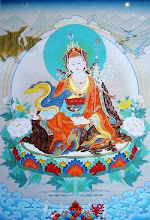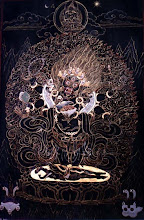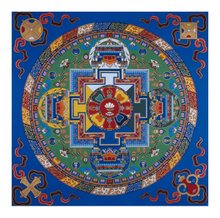 Images of Enlightenment is organized around 32 full-color plates, paintings by Andy Weber, a UK-based artist trained in Nepal by refugee Tibetan painters and now himself a widely traveled and respected teacher in Europe and North America. (See the artist's website for more examples of his work and his current teaching schedule.) Each chapter of the book begins with a theme, followed by explanations of the handful of paintings that best represent them. The first chapter on the life of the Buddha and the basics of Buddhist philosophy, for example, includes descriptions of paintings of the Buddha, stupas, and the Wheel of Life.
Images of Enlightenment is organized around 32 full-color plates, paintings by Andy Weber, a UK-based artist trained in Nepal by refugee Tibetan painters and now himself a widely traveled and respected teacher in Europe and North America. (See the artist's website for more examples of his work and his current teaching schedule.) Each chapter of the book begins with a theme, followed by explanations of the handful of paintings that best represent them. The first chapter on the life of the Buddha and the basics of Buddhist philosophy, for example, includes descriptions of paintings of the Buddha, stupas, and the Wheel of Life.As an introductory text, the authors cannot hope to cover the nearly 200 deities of Tibetan Buddhism. They manage, though, to provide an informative, well-written, and properly illustrated volume covering some of the most popular images. If you'd like to learn more about the methods and materials used in painting thangka, you might like to see Jackson and Jackson's Tibetan Thangka Painting: Methods & Materials. The paintings used in this book, while well executed, are quite simple and not cluttered with many of the background items found in many thangka. There is, therefore, little in this book explaining many of the minor elements of Tibetan painting. For a more thorough treatment of symbolism and iconography, see Robert Beer's A Handbook of Tibetan Buddhist Symbols. If you'd like to see larger and more elaborately and finely detailed thangka, have a look at two collections in Romio Shrestha's Celestial Gallery and Goddesses of the Celestial Gallery.
#



























0 comments:
Post a Comment